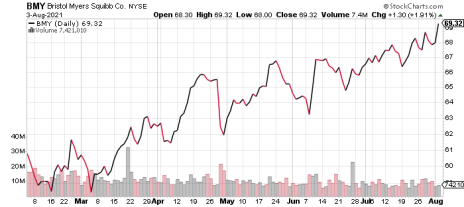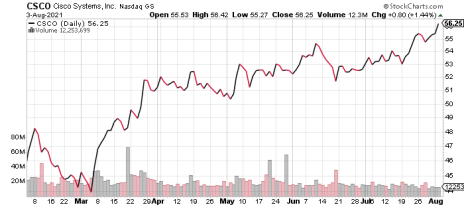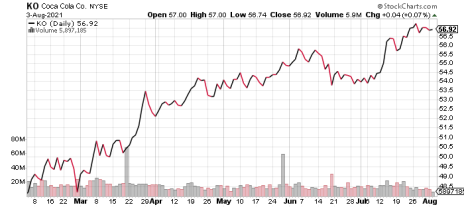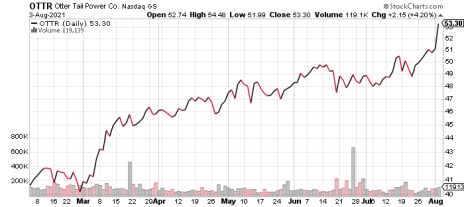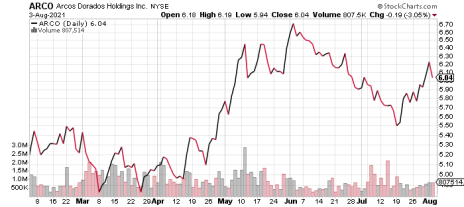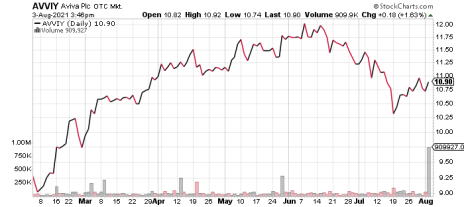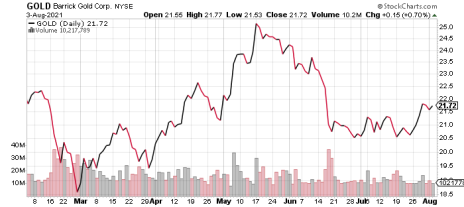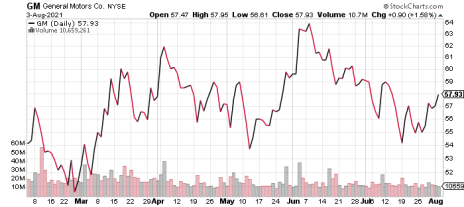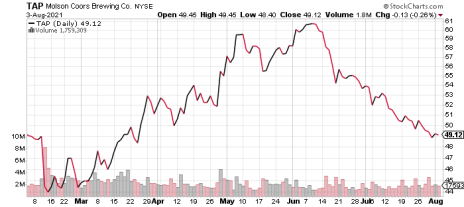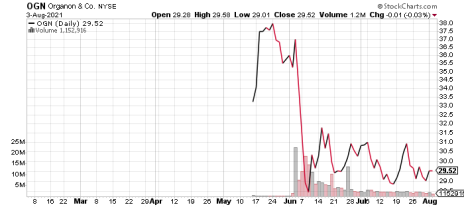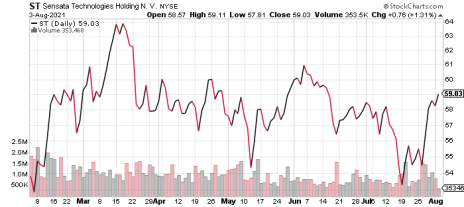Thank you for subscribing to the Cabot Undervalued Stocks Advisor. We hope you enjoy reading the August 2021 issue.
Earnings season is in full gear, and we review the several companies that have reported as well as provide some expectations for those yet to report. General Motors (GM) releases its earnings on Wednesday, August 4, after our publishing deadline – this is a highly anticipated report.
Perhaps the biggest difference between value investing and growth and momentum investing is what to do when a stock price falls. Many investors using growth and momentum strategies have a discipline of selling if a stock price falls 15-20%. This may make excellent sense for these strategies but is the exact opposite of what one using a value strategy should do. With value strategies, one generally should buy when their stocks go down in price. We touch upon this more in today’s note.
I’d like to invite you to our 9th Annual Cabot Investor Conference, held online again this year, on August 17-19, that’s Tuesday – Thursday. You can see presentations by all of our analysts, which will include updates on their areas of expertise and discussions of their best picks.
Please feel free to send me your questions and comments. This newsletter is written for you and the best way to get more out of the letter is to let me know what you are looking for.
I’m best reachable at Bruce@CabotWealth.com. I’ll do my best to respond as quickly as possible.
Cabot Undervalued Stocks Advisor 821
[premium_html_toc post_id="234930"]
Perhaps the Biggest Difference Between Value Investing and Growth and Momentum Investing
As value investors, we look for companies whose shares are out of favor. Typically, these companies have little revenue or earnings growth – maybe their product or service offerings are in slow-growth industries or maybe aren’t quite as in-sync with customer demand as competitors, or perhaps they are pharmaceutical companies with patent expirations looming in the future. There are other potential overhangs, such as sub-par margins, poor capital allocation, temporary regulatory or legal issues or involvement in a recent spin-off transaction.
What attracts us to some of these out-of-favor companies is their enduring value. Their business franchise may need some work, but it isn’t permanently damaged. Importantly, they have manageable balance sheets and enough free cash flow to sustain and build value for investors.
If the enduring value is there, based on our fundamental outlook we can assign a meaningful price target. Then, we want to buy these stocks with enough upside to that price target to make the risks worth our efforts.
One analogy we use is that we are buying $1 bills for 75 cents. If the local dollar bill salesman stopped by our house every day to sell us dollars for 75 cents, we’d buy as many as we reasonably could. If, one day, he decided to lower the price to only 65 cents, we would buy more. We wouldn’t sell all (or any) of our dollars back to him at the new and lower 65 cent price.
Only if he decided to sell the dollars for, say, $1.10 cents, would we want to cash out.
This is perhaps the biggest difference between value investing and growth and momentum investing. Value investing focuses on valuation – if this key metric gets more attractive (such as when the share price goes down), we buy more. Growth investing focuses on fundamentals – if this key metric gets more attractive (rising estimates, accelerating growth, etc.), it’s time to buy more. For momentum investing – if the key metric gets more attractive (stock price moves higher, faster), it’s time to buy more. When the key metric deteriorates, only then is it time to sell.
All three flavors of investing have merit, it’s just that they focus on different key metrics.
When investors look at value strategies for the first time, the idea of buying when a stock goes down can often seem counterintuitive. Many growth and momentum investors have been trained to sell when a stock drops 15% or 20%. This may be the exact right approach for these strategies, but it is exactly the opposite of what a value strategy emphasizes – buying more when a stock price falls.
As long as there hasn’t been a permanent impairment of the enduring value, buying when the stock price goes down is a key aspect of successful value investing.
Share prices in the table reflect Tuesday (August 3) closing prices. Please note that prices in the discussion below are based on mid-day August 3 prices.
Note to new subscribers: You can find additional color on past earnings reports and other news on recommended companies in prior editions and weekly updates of the Cabot Undervalued Stocks Advisor on the Cabot website.
Send questions and comments to Bruce@CabotWealth.com.
Upcoming Earnings Releases
August 4: General Motors (GM)
August 9: Barrick Gold (GOLD)
August 11: Arcos Dorados (ARCO)
August 12: Aviva plc (AVVIY)
August 12: Organon & Co. (OGN)
August 18: Cisco Systems (CSCO)
Today’s Portfolio Changes
Cisco (CSCO) – Raising our price target from 55 to 60.
Portfolio changes during the past month
None.
Growth & Income Portfolio
Growth & Income Portfolio stocks are generally higher-quality, larger-cap companies that have fallen out of favor. They usually have some combination of attractive earnings growth and an above-average dividend yield. Risk levels tend to be relatively moderate, with reasonable debt levels and modest share valuations.
| Stock (Symbol) | Date Added | Price Added | 8/3/21 | Capital Gain/Loss | Current Dividend Yield | Price Target | Rating |
| Bristol-Myers Squibb (BMY) | 04-01-20 | 54.82 | 69.31 | 26.4% | 2.8% | 78.00 | Strong Buy |
| Cisco Systems (CSCO) | 11-18-20 | 41.32 | 56.25 | 36.1% | 2.6% | 60.00 | Buy |
| Coca-Cola (KO) | 11-11-20 | 53.58 | 56.92 | 6.2% | 2.9% | 64.00 | Buy |
| Dow Inc (DOW) * | 04-01-19 | 53.50 | 62.23 | 16.3% | 4.5% | 78.00 | Hold |
| Merck (MRK) | 12-9-20 | 83.47 | 76.41 | -8.5% | 3.4% | 99.00 | Buy |
| Otter Tail Corporaton (OTTR) | 5-25-21 | 47.10 | 53.37 | 13.3% | 2.9% | 57.00 | Buy |
Bristol Myers Squibb Company (BMY) shares sell at a low valuation due to worries over patent expirations for Revlimid (starting in 2022) and Opdivo and Eliquis (starting in 2026). However, the company is working to replace the eventual revenue losses by developing its robust product pipeline while also acquiring new treatments (notably with its acquisitions of Celgene and MyoKardia), and by signing agreements with generics competitors to forestall their competitive entry. The likely worst-case scenario is flat revenues over the next 3-5 years. Bristol should continue to generate vast free cash flow, helped by a $2.5 billion cost-cutting program, and has a relatively modest debt level.Notes: DOW price is based on April 1, 2019 closing price following spin-off from DWDP. The TSN price is as of the date of our Sell rating.
On July 28, Bristol reported encouraging second-quarter results. Revenues grew 13% from a year ago (adjusted for currency changes) although comparisons were against a pandemic-weakened quarter a year ago when customer inventories were drawn down. Revenues were 4% above the consensus estimate. This is important because one of the major debates on Bristol is its ability to grow revenues. The “beat” here is an indicator that we are on the right track.
All three of the top priority brands and nearly all of the others showed very respectable and positive revenue growth. Bristol’s pipeline remains well-positioned.
Adjusted earnings per share of $1.93 rose 18% from a year ago and were slightly higher than the $1.90 consensus estimate. Netting out all of the various charges and other items, the operating margin of 44.6% improved from the $43.0% margin a year ago. Net debt of $32.0 billion was trimmed from $34.4 billion at year end – an important metric that we are watching.
Bristol reiterated their full-year 2021 revenue and earnings guidance. We anticipate more color on its current treatments and pipeline, as well as its financial outlook, at the investor day later this year.
There was no other significant company-specific news in the past week.
BMY shares rose 1% in the past week and have about 14% upside to our 78 price target. The shares have moved above their 2020 pre-pandemic high and trade just below their 2018 high. We remain patient with BMY shares.
The stock trades at a low 9.2x estimated 2021 earnings of $7.49 (up fractionally from last week). On 2022 estimated earnings of $8.07 (up a cent), the shares trade at 8.5x. Either we are completely wrong about the company’s fundamental strength, or the market must eventually recognize Bristol’s earnings stability and power. We believe the earning power, low valuation and 2.9% dividend yield that is well-covered by enormous free cash flow make a compelling story. STRONG BUY
Cisco Systems (CSCO) is facing revenue pressure as customers migrate to the cloud and thus need less of Cisco’s equipment and one-stop-shop services. Cisco’s prospects are starting to improve under a relatively new CEO, who is shifting Cisco toward a software and subscription model and is rolling out new products, helped by its strong reputation and entrenched position within its customers’ infrastructure. The company is highly profitable, generates vast cash flow (which it returns to shareholders through dividends and buybacks) and has a very strong balance sheet.
There was no significant company-specific news in the past week.
CSCO shares rose 1% in the past week and are trading above our 55 price target. We are nudging up our price target to 60. In general, we are reluctant to raise our targets this close to an earnings report, but given what we know and anticipate regarding Cisco’s fundamental improvements, we are willing to provide some price target flexibility.
The shares trade at 17.4x estimated FY2021 earnings of $3.21 (unchanged in the past week). On FY2022 earnings (which ends in July 2022) of $3.42 (unchanged), the shares trade at 16.3x. On an EV/EBITDA basis on FY2021 estimates, the shares trade at a 12.1x multiple. CSCO shares offer a 2.7% dividend yield. We continue to like Cisco. BUY
Coca-Cola (KO) is best-known for its iconic soft drinks yet nearly 40% of its revenues come from non-soda beverages across the non-alcoholic spectrum. Its global distribution system reaches nearly every human on the planet. Coca-Cola’s longer-term picture looks bright but the shares remain undervalued due to concerns over the pandemic, the secular trend away from sugary sodas, and a tax dispute which could cost as much as $12 billion (likely worst-case scenario). The relatively new CEO James Quincey (2017) is reinvigorating the company by narrowing its oversized brand portfolio, boosting its innovation and improving its efficiency, as well as improving its health and environmental image. Coca-Cola’s balance sheet is sturdy, and its growth investing, debt service and dividend are well-covered by free cash flow.
On July 21, Coca-Cola reported adjusted second-quarter earnings of $0.68/share, beating the consensus earnings estimate of $0.56/share and much stronger than the $0.42 earned a year ago during the depths of the pandemic. The company raised its full-year organic revenue growth guidance to 12-14% (from about 9%) and raised its full-year adjusted EPS guidance to $2.20 to $2.24 (about 4% higher than their prior guidance). All-in, an encouraging quarter.
Revenues grew 42% from a year ago, driven by 26% growth in volumes and 11% improvement in pricing and mix, with a 5% tailwind from currencies. The increases are flattered by the easy comparison to the year-ago quarter which suffered the worst of the pandemic. Compared to two years ago, unit case volumes matched the two-year-ago level, not bad considering that parts of the global economy remained subdued.
Gross margins and operating margins expanded, as we had expected, as more of the incremental revenues fell to the bottom line due to Coke’s somewhat fixed cost base.
Coca-Cola generated $3.9 billion of operating cash flow in the quarter and has generated $5.5 billion year-to-date, much stronger than the year-ago $2.7 billion a year ago. The company is on track to generate $9 billion of free cash flow this year, up from their prior guidance for $8.5 billion.
From a capital allocation perspective, Coke is doing the right things. As a mature company that generates a lot of free cash flow, it is paying out about 70-75% of its free cash flow as dividends, even as it makes sound investments in its business and prunes its cost structure. Most of the rest of the free cash flow is being used to pay down debt. The company has cut its debt by $2.9 billion, or close to 10%, so far this year.
On Tuesday, competitor PepsiCo announced the sale of a 61% controlling stake in its Tropicana and other juice beverages businesses to a private equity firm. The divestiture will help Pepsi shift away from lower-margin and sugary beverages. Coca-Cola owns the Minute Maid and Simply juice brands so it will be interesting to see if they follow Pepsi’s lead. Coke recently shut down its Odwalla juice brand and sold its Zico juice operations. Pepsi will receive $3.3 billion in pre-tax proceeds from the sale – generally in the neighborhood of what Coke might receive if it offloaded some of its major juice operations.
KO shares fell fractionally in the past week and have about 13% upside to our 64 price target. The stock continues to reflect Coke’s earnings power even as the pandemic resurgence may delay a full return to normal in consumption patterns.
While the valuation is not statistically cheap, at 25.3x estimated 2021 earnings of $2.25 (flat in the past week) and 23.4x estimated 2022 earnings of $2.43 (flat), the shares remain undervalued given the company’s future earning power and valuable franchise. Also, the value of Coke’s partial ownership of a number of publicly traded companies (including Monster Beverage) is somewhat hidden on the balance sheet, yet is worth about $23 billion, or 9% of Coke’s market value. This $5/share value provides additional cushion supporting our 64 price target. KO shares offer an attractive 3.0% dividend yield. BUY
Dow Inc. (DOW) merged with DuPont to create DowDuPont, then split into three companies in 2019 based on product type. The new Dow is the world’s largest producer of ethylene/polyethylene, the most widely used plastics. Investors undervalue Dow’s hefty cash flows and sturdy balance sheet largely due to its uninspiring secular growth traits and its cyclicality. The shares are driven by: 1) commodity plastics prices, which are often correlated with oil prices and global growth, along with competitors’ production volumes; 2) volume sold, largely driven by global economic conditions, and 3) ongoing efficiency improvements (a never-ending quest of all commodity companies). Investors worry about a cyclical peak and whether Dow will squander its vast free cash flow. We see Dow as having more years of strong profits before capacity increases signal a cyclical peak, and expect the company to continue its strong dividend, reduce its pension and debt obligations, repurchase shares slowly and restrain its capital spending.
On July 22, Dow reported a strong second quarter, with adjusted earnings of $2.72/share, about 16% above the consensus estimate of $2.35 and sharply higher than the $(0.26) loss a year ago in the depths of the pandemic. Even compared to the first-quarter earnings of $1.36, the second quarter was impressive. Sales grew 66%, but the pandemic year-ago period makes this comparison meaningless. Dow saw strength across all of its segments. Management has an encouraging outlook for volumes and pricing and its ability to generate higher profits on comparable revenues. While profits may be peaking in coming quarters, they will likely remain elevated rather than fall off sharply. Industry capacity increases are coming next year, but we do not see large price cuts from our current vantage point.
While the company showed strong profits, only about half of its cash operating profits (EBITDA) flowed through to cash flow. This is a bit surprising, as more should make its way to cash flow. Also, while the company paid down $1.1 billion of debt, the net debt is actually slightly higher than at year end – again, surprising as we would have expected at least a $1-2 billion net debt reduction.
Perhaps a tad annoying, Dow’s share count rose by 13.6 million shares over the past year (even after the share repurchases), worth a total of $816 million at the current share price. This almost-2% increase is too high, and would consume over 8% of the company’s annual pre-tax profits if converted into an expense.
Overall, we are holding tight with our Buy rating as the shares look undervalued compared to their earnings and cash flow generation prospects.
There was no other significant company-specific news in the past week.
Dow shares were flat this past week and have 26% upside to our 78 price target.
The shares trade at 10.6x estimated 2022 earnings of $5.85 (unchanged this past week reflecting strong second-quarter earnings and expectations for a slower decline after reaching peak earnings, estimated to occur in the third quarter). The estimate for 2021 earnings was also unchanged.
Analysts are somewhat pessimistic about 2022 earnings (they assume a 31% decline from 2021). If the 2022 estimate continues to tick up, the shares will likely follow, although Dow’s cyclical earnings and investor fears of an eventual downcycle will ultimately limit Dow’s upside. The high 4.5% dividend yield adds to the shares’ appeal. In a prolonged downcycle, the dividend could be cut, but that could be years away and even then a cut isn’t a certainty if Dow can manage its balance sheet and down-cycle profits reasonably well. HOLD
Merck (MRK) shares are undervalued as Keytruda, a blockbuster oncology treatment (about 30% of revenues), will face generic competition in late 2028. Also, its Januvia diabetes treatment may see generic competition next year, and like all pharmaceuticals it is at risk from possible government price controls. Yet, Keytruda is an impressive franchise that is growing at a 20% rate and will produce solid cash flow for nearly seven more years, providing the company with considerable time to replace the potential revenue loss. Merck’s new CEO, previously the CFO, will likely accelerate Merck’s acquisition program, which adds both return potential and risks to the story. The company is highly profitable and has a solid balance sheet. It spun off its Organon business in June and we think it will divest its animal health sometime in the next five years.
On July 29, Merck’s reported satisfactory second-quarter results. Revenues grew 19% (excluding favorable currencies) and were slightly ahead of consensus estimates. Much of the strong growth was due to an easy comparison with a year ago when sales were weak as customers drew down their inventories rather than buy new treatments. However, the strength was encouraging as it indicates durable underlying demand. Keytruda sales surged 20% ex-currency, helping offset modest weakness elsewhere. Merck said that Keytruda is on track to become the world’s top-selling drug by 2023. Keytruda continues to win new uses, which will expand its franchise and growth prospects. Gardasil revenues surged 78% as patients returned to doctors’ offices, and this trend should continue to provide a tailwind for Merck. Pharmaceutical sales overall grew 18% while Animal Health revenues grew 27% (ex-currency).
Merck raised its full-year revenue guidance by 2-4 percentage points to reflect the quarter and likely ongoing strength. The company reiterated its confidence in its new product pipeline, such that it doesn’t anticipate the need for a major disruptive acquisition, although it clearly is planning on small-to-large deals, backed by its already-strong balance sheet that has been bolstered by $9 billion in fresh cash from the Organon spin-off. Turning around a research department takes a lot of time, and Merck’s efforts seem to be starting to pay off.
Adjusted earnings of $1.31/share increased 28% from a year ago but fell slightly short of the $1.33 consensus estimate. Higher costs led to the earnings “miss” but this seems more like analysts got too optimistic rather than any fundamental issues with the company’s cost structure. Merck carries costs from Organon that it can trim away in future quarters. Merck’s balance sheet and cash flow looked solid.
Like all pharma companies, Merck would likely pay higher taxes under various tax law changes currently being considered.
Merck shares slipped 1% this past week and have about 30% upside to our 99 price target.
Valuation is an attractive 13.8x this year’s estimated earnings of $5.53 (down about 1% in the past week. Merck produces generous free cash flow to fund its current dividend (now yielding 3.4%) as well as likely future dividend increases, although its shift to a more acquisition-driven strategy will slow the pace of increases. BUY
Otter Tail Corporation (OTTR) is a rare utility/industrial hybrid company, with a $2 billion market cap. The electric utility has a solid and high-quality franchise, with a balanced mix of generation, transmission and distribution assets that produce about 75% of the parent company’s earnings, supported by an accommodative regulatory environment. The industrial side includes the Manufacturing and Plastics segments. Otter Tail has an investment grade balance sheet, produces solid earnings and prides itself on steady dividend growth. The unusual utility/manufacturing structure is creating a discounted valuation, which might make the company a target for activists, as the two parts may be worth more separately, perhaps in the hands of larger, specialized companies.
On August 2, Otter Tail reported strong second-quarter earnings and significantly raised its full-year guidance. Earnings of $1.01/share rose 141% from a year ago and was nearly double the $0.56/share consensus estimate. Full-year guidance was raised by about 40% to $3.58 (midpoint of the range).
The surge in profits came mostly from the plastics segment, where operating income of $31 million was 4x the year-ago profits. PVC resin supplies were exceptionally tight, largely due to the Texas winter storms, creating a PVC pipe shortage that allowed Otter Tail to sharply raise its PVC pipe prices by as much as 74%. The company anticipated that these unusual conditions would last through 2021 but moderate into 2022.
Manufacturing segment operating income rose sharply but the dollar increase was modest relative to the increase in Plastics segment profits. Electric segment profits rose a steady 5%. It was a solid quarter all-around for Otter Tail.
The electric utility is progressing through its Minnesota rate case – we anticipate a benign outcome. Otter Tail’s balance sheet remains in good shape, although the steady expansion of its electric utility rate base continues to siphon off considerable cash flow. The company declared its unchanged $0.39/share quarterly dividend.
OTTR shares rose 8% in the past week, including a 4% midday jump today following their earnings report, and trade at their post-pandemic high. The stock has about 6% upside to our 57 price target. The stock trades at about 17.4x estimated 2021 earnings of $3.09 (up 18% partly reflecting the strong earnings report). On the new 2021 earnings guide of $3.58, the stock trades at an attractive 15.0x multiple. The shares offer a 2.9% dividend yield. BUY
Buy Low Opportunities Portfolio
Buy Low Opportunities Portfolio stocks include a wide range of value opportunities, often with considerable upside. This group may include stocks across the quality and market cap spectrum, including those with relatively high levels of debt and a less-clear earnings outlook. The stocks may not pay a dividend. In all cases, the shares will trade at meaningful discounts to our estimate of fair value.
| Stock (Symbol) | Date Added | Price Added | 8/3/21 | Capital Gain/Loss | Current Dividend Yield | Price Target | Rating |
| Arcos Dorados (ARCO) | 04-28-21 | 5.41 | 6.04 | 11.6% | 0.0% | 7.50 | Buy |
| Aviva (AVVIY) | 03-03-21 | 10.75 | 10.86 | 1.0% | 5.4% | 14.00 | Buy |
| Barrick Gold (GOLD) | 03-17-21 | 21.13 | 21.72 | 2.8% | 1.7% | 27.00 | Buy |
| General Motors (GM) | 12-31-19 | 36.60 | 57.88 | 58.1% | — | 69.00 | Hold |
| Molson Coors (TAP) | 08-05-20 | 36.53 | 49.13 | 34.5% | — | 69.00 | Buy |
| Organon (OGN) | 06-07-21 | 31.42 | 29.51 | -6.1% | — | 46.00 | Buy |
| Sensata Technologies (ST) | 02-17-21 | 58.57 | 59.07 | 0.9% | — | 75.00 | Buy |
Arcos Dorados (ARCO), which is Spanish for “golden arches,” is the world’s largest independent McDonald’s franchisee. Based in stable Uruguay and listed on the NYSE, the company produces about 72% of its revenues in Brazil, Mexico, Argentina and Chile. Arcos’ leadership looks highly capable, led by the founder/chairman who owns a 38% stake. The shares are undervalued as investors worry about the pandemic, as well as political/social unrest, inflation and currency devaluations. However, the company is well-managed and positioned to benefit as local economies reopen, and it has the experience to successfully navigate the complex local conditions. Debt is reasonable relative to post-recovery earnings, and the company is currently producing positive free cash flow.
In its second-quarter report, McDonald’s highlights strong comparable sales in its Brazil markets, which are licensed to Arcos, providing incremental confidence in Arco’s upcoming earnings report next Wednesday.
ARCO shares rose 2% this past week and have about 25% upside to our 7.50 price target. The stock will likely remain volatile until we have more clarity on its earnings and the effects of the pandemic, including the Delta variant, on its outlook. We remain steady in our conviction in the company’s recovery. The low share price offers a chance to add to or start new positions in ARCO.
The stock trades at 21.5x estimated 2022 earnings per share of $0.28 (down a cent from a week ago). The 2021 estimate slipped to $0.04 – it appears that analysts are throwing in the towel on this year’s earnings, and pushing out estimates for a recovery to next year or so. While disappointing that we have to wait, we don’t see any permanent damage to the company’s underlying value, and so we retain our Buy rating and price target. In some ways, the slow recovery is a positive, as it could push weaker competitors out of the market. The 2023 consensus estimate of $0.34 slipped a cent from last week. BUY
Aviva, plc (AVVIY), based in London, is a major European insurance company specializing in life insurance, savings and investment management products. Amanda Blanc was hired as the new CEO last year to revitalize Aviva’s laggard prospects. She has divested operations around the world to aggressively re-focus the company on its core geographic markets (UK, Ireland, Canada), and is improving Aviva’s product competitiveness, rebuilding its financial strength and trimming its bloated costs. Aviva’s dividend has been reduced to a more predictable and sustainable level with a modest upward trajectory. Excess cash balances are being directed toward debt reduction and potentially sizeable special dividends.
There was no significant company-specific news in the past week. We anticipate minimal news until Aviva reports earnings next Thursday, August 12.
Aviva shares rose 1% this past week and have about 28% upside to our 14 price target.
The recurring quarterly dividend of $0.14/share produces a 5.3% yield. In an era that features investment grade bond yields of 1.6%, Aviva makes an interesting bond proxy, particularly given what appears to be a resilient base dividend. The likely upcoming special dividends on top of this add extra appeal.
The stock trades at 7.7x estimated 2021 earnings per ADS of $1.42 (down 3% in the past week) and at about 94% of tangible book value. BUY
Barrick Gold (GOLD), based in Toronto, is one of the world’s largest and highest-quality gold mining companies. About 50% of its production comes from North America, with the balance from Africa/Middle East (32%) and Latin America/Asia Pacific (18%). The market has little interest in Barrick shares. Yet, Barrick will continue to improve its operating performance (led by its new and highly capable CEO), generate strong free cash flow at current gold prices, and return much of that free cash flow to investors while making minor but sensible acquisitions. Also, Barrick shares offer optionality – if the unusual economic and fiscal conditions drive up the price of gold, Barrick’s shares will rise with it. Given their attractive valuation, the shares don’t need this second (optionality) point to work – it offers extra upside. Barrick’s balance sheet has more cash than debt. Major risks include the possibility of a decline in gold prices, production problems at its mines, a major acquisition and/or an expropriation of one or more of its mines.
There was no significant company-specific news in the past week. Barrick is expected to report earnings of $0.26/share on Monday, August 9.
Barrick shares rose 4% this past week and have about 24% upside to our 27 price target. The mid-week jump in gold prices, likely spurred on by Fed chairman Powell’s comments on July 28 that suggest a much more inflationary definition of “transitory” than many (including us) had anticipated. One emerging unknown is whether Powell will be renominated for the role when his term expires this coming February. Its hard to imagine a new Fed chair being more accommodative than the current chair, but we’ve been surprised on this before.
The price target is based on 7.5x estimated 2021 EBITDA and a modest premium to its $25/share net asset value. Commodity gold rose about 1% to $1,812/ounce. Sentiment has slightly firmed for gold. Despite the recent report of 5.4% inflation, the 10-year Treasury yield slipping into the 1.18% range, and ongoing tensions with China, gold has hardly moved.
On its recurring $.09/quarter dividend, GOLD shares offer a reasonable 1.7% dividend yield. Barrick will pay an additional $0.42/share in special distributions this year, lifting the effective dividend yield to 3.6%. BUY
General Motors (GM) is making immense progress with its years-long turnaround. It is perhaps 85% of the way through its gas-powered vehicle turnaround, and is well-positioned but in the early stages of its electric vehicle (EV) development. GM Financial will likely continue to be a sizeable profit generator. GM is fully charged for both today’s environment and the EV world of the future, although much of its value is based on the unknown EV future.
GM reports earnings on Wednesday, August 4, with the consensus estimate of $2.25/share. We will be looking for strong revenue and earnings results, yet also would like to hear more color on the chip shortage, vehicle pricing, GM Financial’s profits and credit statistics and GM’s outlook for the rest of the year. For its EV operations, we want to hear more about their 2022 EV product lineup, their battery and other EV development initiatives and their outlook for pricing, margins and return on capital for EV vehicles in general over the longer term.
One wildcard would be that GM reinstates its dividend (suspended in April 2020), even if it is not the previous $0.38/share quarterly payout. We don’t expect this, but it would be a strong positive in our view, as it would imply high confidence by the management that it can sustainably generate enough free cash flow for years to fund its ongoing operations and hefty EV investment program, yet have plenty left over for dividends.
GM shares rose 4% this past week and have 19% upside to our 69 price target. The shares have been volatile/weak on concerns that production growth will slow (partly due to the chip shortage) and partly due to concerns that economic growth will decelerate. Another risk that has increased from “will never happen” to “it conceivably could happen” is that China pushes Western car producers out of the country. Following China’s moves in previously Westernized Hong Kong, its crackdown on major capitalist tech companies, its new restrictions on IPOs in the United States and its widening attack on profits of its domestic companies, it isn’t entirely impossible that Western automakers are in line for similar treatment, even if years down the road. Needless to say, such a change would be devastating for GM shares.
Near term, the market appears to be reluctant to upgrade its view of GM shares until there is more color on its 2021 and 2022 earning power.
On a P/E basis, the shares trade at 8.2x estimated calendar 2022 earnings of $7.04 (unchanged this past week). The 2021 estimate also was unchanged. The P/E multiple is helpful, but not a precise measure of GM’s value, as it has numerous valuable assets that generate no earnings (like its Cruise unit, which is developing self-driving cars and produces a loss), its nascent battery operations, and its other businesses with a complex reporting structure, nor does it factor in GM’s high but unearning cash balance which offsets its interest-bearing debt. However, it is useful as a rule-of-thumb metric, and provides some indication of the direction of earnings estimates, and so we will continue its use here. HOLD
Molson Coors Beverage Company (TAP) is one of the world’s largest beverage companies, producing the highly recognized Coors, Molson, Miller and Blue Moon brands as well as numerous local, craft and specialty beers. About two-thirds of its revenues come from the United States, where it holds a 24% market share. Investors worry about Molson Coors’ lack of revenue growth due to its relatively limited offerings of fast-growing hard seltzers and other trendier beverages. Our thesis for this company is straight-forward – a reasonably stable company whose shares sell at an overly discounted price. Its revenues are resilient, it produces generous cash flow and is reducing its debt. A new CEO is helping improve its operating efficiency and expand carefully into more growthier products. The company recently reinstated its dividend.
The company’s second-quarter report on July 29 was encouraging. Revenues rose 17%, or +14% excluding currency tailwinds. Sales in Europe in local currencies surged 52% compared to the dry year-ago period, as the economies there reopened, with volumes, pricing and mix all contributing to the increase. Sales in the North America segment, in local currencies, rose 8%, helped by a recovery in Latin America. Revenues were about 4% ahead of the consensus estimate.
Adjusted net income of $1.58/share rose 2% from a year ago and was 17% above the consensus estimate. Adjusted EBITDA fell 1.3% ex-currency effects. Profit growth lagged revenue growth as Molson spent much more on marketing this year compared to the belt-tightening a year ago during the pandemic, and as inflation rose in its transportation, brewery and packaging materials costs. Also, a year ago, the company won a tax dispute, distorting the comparison with this year.
Beating the revenue and earnings estimates is important as it supports our view that investors don’t fully appreciate the resiliency in Molson’s business. The company reaffirmed its 2021 full-year guidance.
The adjusted earnings exclude a huge $102 million gain from hedges that the company has on various input costs. These hedges remain in place, and as they are closed out Molson will include those gains in their core profit numbers. This complicated the accounting but the economic effect is clear – Molson’s actual all-in costs aren’t quite as high as they appear thanks to the hedges.
Molson’s debt balance is unchanged from year end but cash is starting to accumulate. After quarter end, the company repaid $1 billion in debt upon its maturity. The company continues to generate good free cash flow and will restart its quarterly dividend at $0.34/share as disclosed a few weeks ago.
The company is paring as many as 100 smaller and/or low-potential products, many of which are in the economy segment, from its roster. This should boost profits. Also, its Topo Chico Hard Seltzer, Vizzy Hard Lemonade and ZOA products, which are new, are selling exceptionally well.
TAP shares fell 3% in the past week and have about 40% upside to our 69 price target.
The shares trade at 12.3x estimated 2021 earnings of $4.00 (up 10 cents this past week). Estimates for 2022 rose seven cents.
On an EV/EBITDA basis, or enterprise value/cash operating profits, the shares trade for about 8.4x current-year estimates, still among the lowest valuations in the consumer staples group and below other brewing companies. BUY
Organon & Company (OGN) is a mid-sized ($6.3 billion revenues) S&P 500 pharmaceutical producer that was recently spun off from Merck. About 80% of its sales come from outside of the United States. The shares are undervalued, as Organon is a new company with little following, it faces patent expirations, particularly with its Nexplanon product, and as it is under pricing pressure in China from government buying programs. The market sees several years of 3-4% revenue decay, or worse.
We have a more favorable outlook. In the Women’s Health Segment (23% of revenues), Nexplanon has a highly valuable franchise with solid 10% growth potential yet has a more resilient revenue stream than the market is giving it credit for. The segment’s fertility treatments are well-positioned to grow, particularly in China. Organon’s Established Brands segment (68% of revenues) is a collection of nearly 50 mostly off-patent therapies, of which only about a tenth of its revenues face patent expirations over the next four years. Much of the Chinese revenue pressures are in the past. The Biosimilars segment (9% of revenues) has solid double-digit growth potential as it rolls out new treatments. Organon will boost its growth through smart yet modest-sized acquisitions and perhaps eventually divest its Established Brands segment. The management and board appear capable, the company produces robust free cash flow, has modestly elevated debt and will pay a reasonable dividend.
There was no significant company-specific news in the past week.
OGN shares fell 1% in the past week and have about 57% upside to our 46 price target (using the same target as the Cabot Turnaround Letter).
The shares trade at 4.9x estimated 2021 earnings of $5.98 and 4.9x estimated 2022 earnings of $5.92. These are remarkably low valuations. Estimates were unchanged this past week. The company has yet to report as an independent company. Curiously, the consensus estimate for 2023 is a more robust $6.23.
On an EV/EBITDA basis, or enterprise value/cash operating profits, the shares trade for about 7.3x current year estimates, also quite low. BUY
Sensata Technologies (ST) is a $3.8 billion (revenues) producer of nearly 47,000 highly engineered sensors used by automotive (60% of revenues), heavy vehicle, industrial and aerospace customers. About two-thirds of its revenues are generated outside of the United States, with China producing about 21%. Investors undervalue Sensata’s durable franchise. Its sensors are typically critical components that generally produce high profit margins. Also, as the sensors’ reliability is vital to safely and performance, customers are reluctant to switch to another supplier that may have lower prices but also lower or unproven quality. Sensata has an arguably under-leveraged balance sheet and generates healthy free cash flow. The relatively new CEO will likely continue to expand the company’s growth potential through acquisitions.
Once a threat, electric vehicles are now an opportunity, as the company’s expanded product offering (largely acquired) allows it to sell more content into an EV than it can into an internal combustion engine vehicle. Risks include a possible automotive cycle slowdown, chip supply issues, geopolitical issues with China, currency and over-paying/weak integration related to its acquisitions.
On July 27, Sensata reported second-quarter adjusted earnings per share of $0.95, sharply higher than $0.18 a year ago and above the $0.87 consensus estimate. Revenues of $993 million set a record, were 72% higher than a year ago and were also above estimates. The jump in revenues and profits reflects a rebound from pandemic-weakened conditions a year ago when many of Sensata’s customers were shut down. Compared to the industry, Sensata grew considerably faster.
The company raised its full-year guidance. Adjusted EPS guidance was raised by about 5% to $3.52, while sales guidance was raised about 1%. The guidance implies a modest further increase in Sensata’s operating margin to 21.0%, as the company seems confident that it can offset rising costs by raising its own prices. Sensata trimmed its auto industry production outlook.
Cash flow was robust and net debt increased modestly to fund the Xirgo acquisition. Rising earnings are helping reduce the company’s leverage as measured by net debt/EBITDA.
There was no other significant company-specific news in the past week.
ST shares rose about 6% this past week and have about 28% upside to our 75 price target.
The stock trades at 14.1x estimated 2022 earnings of $4.17 (up about 2.5% this past week). On an EV/EBITDA basis, ST trades at 11.0x estimated 2022 EBITDA. BUY
Disclosure: The chief analyst of the Cabot Undervalued Stocks Advisor personally holds shares of every recommended security, except for “New Buy” recommendations. The chief analyst may purchase or sell recommended securities but not before the fourth day after any changes in recommendation ratings has been emailed to subscribers. “New Buy” recommendations will be purchased by the chief analyst as soon as practical following the fourth day after the newsletter issue has been emailed to subscribers.
Strong Buy – This stock offers an unusually favorable risk/reward trade-off, often one that has been rated as a Buy yet the market has sold aggressively for temporary reasons. We recommend adding to existing positions.
Buy – This stock is worth buying.
Hold – The shares are worth keeping but the risk/return trade-off is not favorable enough for more buying nor unfavorable enough to warrant selling.
Sell – This stock is approaching or has reached our price target, its value has become permanently impaired or changes in its risk or other traits warrant a sale.
Note for stock table: For stocks rated Sell, the current price is the sell date price.
The next Cabot Undervalued Stocks Advisor issue will be published on September 1, 2021.
Cabot Wealth Network
Publishing independent investment advice since 1970.
President & CEO: Ed Coburn
Chief Investment Strategist: Timothy Lutts
Cabot Heritage Corporation, doing business as Cabot Wealth Network
176 North Street, PO Box 2049, Salem, MA 01970 USA
800-326-8826 | support@cabotwealth.com | CabotWealth.com
Copyright © 2021. All rights reserved. Copying or electronic transmission of this information without permission is a violation of copyright law. For the protection of our subscribers, copyright violations will result in immediate termination of all subscriptions without refund. Disclosures: Cabot Wealth Network exists to serve you, our readers. We derive 100% of our revenue, or close to it, from selling subscriptions to our publications. Neither Cabot Wealth Network nor our employees are compensated in any way by the companies whose stocks we recommend or providers of associated financial services. Employees of Cabot Wealth Network may own some of the stocks recommended by our advisory services. Disclaimer: Sources of information are believed to be reliable but they are not guaranteed to be complete or error-free. Recommendations, opinions or suggestions are given with the understanding that subscribers acting on information assume all risks involved. Buy/Sell Recommendations: are made in regular issues, updates, or alerts by email and on the private subscriber website.
Subscribers agree to adhere to all terms and conditions which can be found on CabotWealth.com and are subject to change. Violations will result in termination of all subscriptions without refund in addition to any civil and criminal penalties available under the law.

